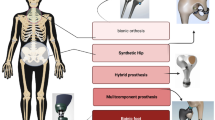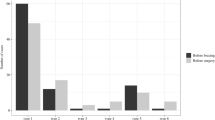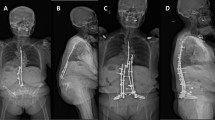Abstract
Purpose
To evaluate the safety and efficacy of a system aiming to correct scoliosis called “electromagnetically controlled shape-memory alloy rods” (EC-SMAR) used in a rabbit model.
Methods
We heat-treated shape-memory alloy (SMA) rods to achieve a transition temperature between 34 and 47 °C and a C-shape austenite phase. We then developed a water-cooled generator capable of generating an alternating magnetic field (100 kHz) for induction heating. We next studied the efficacy of this system in vitro and determined some parameters prior to proceeding with animal experiments. We then employed a rabbit model, in which we fixed a straight rod along the spinous processes intraoperatively, and conducted induction heating postoperatively every 4 days for 1 month, while performing periodic X-ray assessments.
Results
Significant kyphotic deformations with Cobb angles of about 45° (p < 0.01) were created in five rabbits, and no complications occurred throughout the experiment. The rabbits are still very much alive and do not show any signs of discomfort.
Conclusions
This is the first system that can modulate spinal deformation in a gradual, contactless, noninvasive manner through electromagnetic induction heating applied to SMA alloy rods. Although this study dealt with healthy spines, it provides promising evidence that this device also has the capacity to correct human kyphosis and even scoliosis in the future.
Graphic abstract
These slides can be retrieved under Electronic Supplementary Material.










Similar content being viewed by others
Data availability
The raw/processed data required to reproduce these findings cannot be shared at this time as the data also form a part of an ongoing study.
References
Ahmad A, Subramanian T, Panteliadis P, Wilson-Macdonald J, Rothenfluh DA, Nnadi C (2017) Quantifying the ‘law of diminishing returns’ in magnetically controlled growing rods. Bone Joint J 99-B(12):1658–1664. https://doi.org/10.1302/0301-620x.99b12.bjj-2017-0402.r2
Polly DW Jr, Ackerman SJ, Schneider K, Pawelek JB, Akbarnia BA (2016) Cost analysis of magnetically controlled growing rods compared with traditional growing rods for early-onset scoliosis in the US: an integrated health care delivery system perspective. Clinicoecon Outcomes Res 8:457–465. https://doi.org/10.2147/CEOR.S113633
Keskinen H, Helenius I, Nnadi C, Cheung K, Ferguson J, Mundis G, Pawelek J, Akbarnia BA (2016) Preliminary comparison of primary and conversion surgery with magnetically controlled growing rods in children with early onset scoliosis. Eur Spine J 25(10):3294–3300. https://doi.org/10.1007/s00586-016-4597-y
Pfeifer R, Hustedt M, Wesling V, Hurschler C, Olender G, Mach M, Gosling T, Muller CW (2013) Noninvasive induction implant heating: an approach for contactless altering of mechanical properties of shape memory implants. Med Eng Phys 35(1):54–62. https://doi.org/10.1016/j.medengphy.2012.03.010
Petrini L, Migliavacca F, Massarotti P, Schievano S, Dubini G, Auricchio F (2005) Computational studies of shape memory alloy behavior in biomedical applications. J Biomech Eng 127(4):716–725. https://doi.org/10.1115/1.1934203
Wever DJ, Elstrodt JA, Veldhuizen AG, v Horn JR (2002) Scoliosis correction with shape-memory metal: results of an experimental study. Eur Spine J 11(2):100–106. https://doi.org/10.1007/s005860100347
Muller CW, ElKashef T, Pfeifer R, Decker S, Neunaber C, Meier K, Fehr M, Wesling V, Gosling T, Hurschler C, Krettek C (2014) Transcutaneous electromagnetic induction heating of an intramedullary nickel–titanium shape memory implant. Int Orthop 38(12):2551–2557. https://doi.org/10.1007/s00264-014-2460-5
Li Q, Zeng Y, Tang X (2010) The applications and research progresses of nickel–titanium shape memory alloy in reconstructive surgery. Aust Phys Eng Sci Med 33(2):129–136. https://doi.org/10.1007/s13246-010-0022-8
Sevcikova J, Pavkova Goldbergova M (2017) Biocompatibility of NiTi alloys in the cell behaviour. Biometals 30(2):163–169. https://doi.org/10.1007/s10534-017-0002-5
Braun JT, Ogilvie JW, Akyuz E, Brodke DS, Bachus KN (2004) Fusionless scoliosis correction using a shape memory alloy staple in the anterior thoracic spine of the immature goat. Spine (Phila Pa 1976) 29(18):1980–1989. https://doi.org/10.1097/01.brs.0000138278.41431.72
Braun JT, Akyuz E, Udall H, Ogilvie JW, Brodke DS, Bachus KN (2006) Three- dimensional analysis of 2 fusionless scoliosis treatments: a flexible ligament tether versus a rigid-shape memory alloy staple. Spine (Phila Pa 1976) 31(3):262–268. https://doi.org/10.1097/01.brs.0000197569.13266.fe
Braun JT, Hines JL, Akyuz E, Vallera C, Ogilvie JW (2006) Relative versus absolute modulation of growth in the fusionless treatment of experimental scoliosis. Spine (Phila Pa 1976) 31(16):1776–1782. https://doi.org/10.1097/01.brs.0000227263.43060.50
Wang Y, Zheng G, Zhang X, Zhang Y, Xiao S, Wang Z (2010) Comparative analysis between shape memory alloy-based correction and traditional correction technique in pedicle screws constructs for treating severe scoliosis. Eur Spine J 19(3):394–399. https://doi.org/10.1007/s00586-009-1207-2
Wang Y, Zheng G, Zhang X, Zhang Y, Xiao S, Wang Z (2011) Temporary use of shape memory spinal rod in the treatment of scoliosis. Eur Spine J 20(1):118–122. https://doi.org/10.1007/s00586-010-1514-7
Newton PO, Farnsworth CL, Upasani VV, Chambers R, Yoon SH, Firkins P (2011) Dual and single memory rod construct comparison in an animal study. Spine (Phila Pa 1976) 36(14):E904–E913. https://doi.org/10.1097/brs.0b013e3181f2d10e
Cheung JPY, Samartzis D, Yeung K, To M, Luk KDK, Cheung KM (2018) A randomized double-blinded clinical trial to evaluate the safety and efficacy of a novel superelastic nickel–titanium spinal rod in adolescent idiopathic scoliosis: 5-year follow-up. Eur Spine J 27(2):327–339. https://doi.org/10.1007/s00586-017-5245-x
Zhang HY, Li QY, Wu ZH, Zhao Y, Qiu GX (2017) Lumbar scoliosis induction in juvenile dogs by three-dimensional modulation of spinal growth using nickel–titanium coil springs. Chin Med J 130(21):2579–2584. https://doi.org/10.4103/0366-6999.213910
Kim YS, Zhang HY, Moon BJ, Park KW, Ji KY, Lee WC, Oh KS, Ryu GU, Kim DH (2007) Nitinol spring rod dynamic stabilization system and Nitinol memory loops in surgical treatment for lumbar disc disorders: short-term follow up. Neurosurg Focus 22(1):E10. https://doi.org/10.3171/foc.2007.22.1.10
Sanchez Marquez JM, Sanchez Perez-Grueso FJ, Fernandez-Baillo N, Gil Garay E (2012) Gradual scoliosis correction over time with shape-memory metal: a preliminary report of an experimental study. Scoliosis 7(1):20. https://doi.org/10.1186/1748-7161-7-20
Akel I, Yazici M (2009) Growth modulation in the management of growing spine deformities. J Child Orthop 3(1):1–9. https://doi.org/10.1007/s11832-008-0145-6
Cheung JP, Samartzis D, Cheung KM (2014) A novel approach to gradual correction of severe spinal deformity in a pediatric patient using the magnetically-controlled growing rod. Spine J 14(7):e7–e13. https://doi.org/10.1016/j.spinee.2014.01.046
Cheung JP, Cahill P, Yaszay B, Akbarnia BA, Cheung KM (2015) Special article: update on the magnetically controlled growing rod: tips and pitfalls. J Orthop Surg (Hong Kong) 23(3):383–390. https://doi.org/10.1177/230949901502300327
Henao J, Aubin CE, Labelle H, Arnoux PJ (2016) Patient-specific finite element model of the spine and spinal cord to assess the neurological impact of scoliosis correction: preliminary application on two cases with and without intraoperative neurological complications. Comput Methods Biomech Biomed Eng 19(8):901–910. https://doi.org/10.1080/10255842.2015.1075010
Muller CW, Pfeifer R, Meier K, Decker S, Reifenrath J, Gosling T, Wesling V, Krettek C, Hurschler C, Kramer M (2015) A novel shape memory plate osteosynthesis for noninvasive modulation of fixation stiffness in a rabbit tibia osteotomy model. Biomed Res Int 2015:1–8. https://doi.org/10.1155/2015/652940
Levitt AB, Robinson K, Chronos NA, Daum W (2003) External heating of stents by radio waves: pilot studies in rabbit aorta. Cardiovascular Radiat Med 4(3):133–138. https://doi.org/10.1016/s1522-1865(03)00166-5
Dunnweber LH, Rodl R, Gosheger G, Schiedel FM (2016) Evaluation of the SMALL nail: drive technology and behavior in situ. Med Eng Phys 38(12):1518–1523. https://doi.org/10.1016/j.medengphy.2016.09.020
Deutsches Electrotechnische Kommission (1991) DIN VDE 0848 part 2; safety in electromagnetic fields: protection of persons in the frequency range of 30 kHz to 300 GHz, p 27. https://doi.org/10.1097/01.rli.0000117881.42422.72
Floren MG, Günther RW, Schmitz-Rode T (2004) Noninvasive inductive stent heating: alternative approach to prevent instent restenosis? Invest Radiol 39(5):264–270
Yamazaki K, Taki M, Ohkubo C (2016) Safety assessment of human exposure to intermediate frequency electromagnetic fields. Electr Eng Jpn 197(4):3–11. https://doi.org/10.1002/eej.22884
Feldman AT, Wolfe D (2014) Tissue processing and hematoxylin and eosin staining. Methods Mol Biol 1180:31–43. https://doi.org/10.1007/978-1-4939-1050-2_3
Qureshi MA, Asad A, Pasha IF, Malik AS, Arlet V (2009) Staged corrective surgery for complex congenital scoliosis and split cord malformation. Eur Spine J 18(9):1249–1254. https://doi.org/10.1007/s00586-009-1099-1
Bridwell KH, Lenke LG, Baldus C, Blanke K (1998) Major intraoperative neurologic deficits in pediatric and adult spinal deformity patients. Incidence and etiology at one institution. Spine (Phila Pa 1976) 23(3):324–331. https://doi.org/10.1097/00007632-199802010-00008
Thirumala PD, Crammond DJ, Loke YK, Cheng HL, Huang J, Balzer JR (2017) Diagnostic accuracy of motor evoked potentials to detect neurological deficit during idiopathic scoliosis correction: a systematic review. J Neurosurg Spine 26(3):374–383. https://doi.org/10.3171/2015.7
Dabney KW, Ehrenshteyn M, Agresta CA, Twiss JL, Stern G, Tice L, Salzman SK (2004) A model of experimental spinal cord trauma based on computer-controlled intervertebral distraction: characterization of graded injury. Spine (Phila Pa 1976) 29(21):2357–2364. https://doi.org/10.1097/01.brs.0000143108.65385.74
Maiman DJ, Myklebust JB, Ho KC, Coats J (1989) Experimental spinal cord injury produced by axial tension. J Spinal Disord 2(1):6–13
Salzman SK, Mendez AA, Dabney KW, Daley JC, Freeman GM, el-Tantawi S, Beckman AL, Bunnell WP (1991) Serotonergic response to spinal distraction trauma in experimental scoliosis. J Neurotrauma 8(1):45–54. https://doi.org/10.1089/neu.1991.8.45
Henao J, Labelle H, Arnoux PJ, Aubin CÉ (2018) Biomechanical simulation of stresses and strains exerted on the spinal cord and nerves during scoliosis correction maneuvers. Spine Deform 6(1):12–19. https://doi.org/10.1016/j.jspd.2017.04.008
Mesquita RC, D’Souza A, Bilfinger TV, Galler RM, Emanuel A, Schenkel SS, Yodh AG, Floyd TF (2013) Optical monitoring and detection of spinal cord ischemia. PLoS ONE 18(12):e83370. https://doi.org/10.1371/journal.pone.0083370
Schwartz DM, Auerbach JD, Dormans JP, Flynn J, Drummond DS, Bowe JA, Laufer S, Shah SA, Bowen JR, Pizzutillo PD, Jones KJ, Drummond DS (2007) Neurophysiological detection of impending spinal cord injury during scoliosis surgery. J Bone Joint Surg Am 89(11):2440–2449. https://doi.org/10.2106/JBJS.F.01476
Liu XM, Wu SL, Chan YL, Chu PK, Chung CY, Chu CL, Yeung KW, Lu WW, Cheung KM, Luk KD (2007) Surface characteristics, biocompatibility, and mechanical properties of nickel–titanium plasma-implanted with nitrogen at different implantation voltages. J Biomed Mater Res A 82(2):469–478. https://doi.org/10.1002/jbm.a.31157
Espinar E, Llamas JM, Michiardi A, Ginebra MP, Gil FJ (2011) Reduction of Ni release and improvement of the friction behaviour of NiTi orthodontic archwires by oxidation treatments. J Mater Sci Mater Med 22(5):1119–1125. https://doi.org/10.1007/s10856-011-4292-9
Shih CC, Lin SJ, Chen YL, Su YY, Lai ST, Wu GJ, Kwok CF, Chung KH (2000) The cytotoxicity of corrosion products of nitinol stent wire on cultured smooth muscle cells. J Biomed Mater Res 52(2):395–403. https://doi.org/10.1002/10974636(200011)52:2%3c395:aid-jbm21%3e3.0.co;2-b
Kapanen A, Ryhänen J, Danilov A, Tuukkanen J (2001) Effect of nickel–titanium shape memory metal alloy on bone formation. Biomaterials 22(18):2475–2480. https://doi.org/10.1016/S0142-9612(00)00435-X
Ryhänen J, Kallioinen M, Tuukkanen J, Lehenkari P, Junila J, NiemeläE SP, Serlo W (1999) Bone modeling and cell-material interface responses induced by nickel–titanium shape memory alloy after periosteal implantation. Biomaterials 20(14):1309–1317. https://doi.org/10.1016/S0142-9612(99)00032-0
Machado LG, Savi MA (2003) Medical applications of shape memory alloys. Braz J Med Biol Res 36(6):683–691. https://doi.org/10.1590/s0100-879x2003000600001
Gao X, Wang L, Zhang J, Wang P, Shen Y (2018) Long fusion arthrodesis stopping at L5 for adult scoliosis: fate of L5-S1 disk and risk factors for subsequent disk degeneration. Clin Spine Surg 31(3):E171–E177. https://doi.org/10.1097/BSD.0000000000000624
Jain VV, Berry CA, Crawford AH, Emans JB, Sponseller PD (2018) Growing rods are an effective fusionless method of controlling early-onset scoliosis associated with neurofibromatosis type 1 (NF1): a multicenter retrospective case series. J Pediatr Orthop 37(8):e612–e618. https://doi.org/10.1097/BPO.0000000000000963
Belkoff SM, Molloy S (2003) Temperature measurement during polymerization of polymethylmethacrylate cement used for vertebroplasty. Spine (Phila Pa 1976) 28(14):1555–1559. https://doi.org/10.1097/01.brs.0000076829.54235.9f
Deramond H, Wright NT, Belkoff SM (1999) Temperature elevation caused by bone cement polymerization during vertebroplasty. Bone 5(2 Suppl):17S–21S. https://doi.org/10.1016/S8756-3282(99)00127-1
Ahn H, Mousavi P, Chin L, Roth S, Finkelstein J, Vitken A, Whyne C (2007) The effect of pre-vertebroplasty tumor ablation using laser-induced thermotherapy on biomechanical stability and cement fill in the metastatic spine. Eur Spine J 16(8):1171–1178. https://doi.org/10.1007/s00586-007-0375-1
Zhao W, Peng ZH, Chen JZ, Hu JH, Huang JQ, Jiang YN, Luo G, Yi GF, Wang H, Jin S, Gao BL (2018) Thermal effect of percutaneous radiofrequency ablation with a clustered electrode for vertebral tumors: in vitro and vivo experiments and clinical application. J Bone Oncol 12:69–77. https://doi.org/10.1016/j.jbo.2018.07.001
An HS, Singh K, Vaccaro AR, Wang G, Yoshida H, Eck J, McGrady L, Lim TH (2004) Biomechanical evaluation of contemporary posterior spinal internal fixation configurations in an unstable burst-fracture calf spine model: special references of hook configurations and pedicle screws. Spine (Phila Pa 1976) 29(3):257–262. https://doi.org/10.1097/01.BRS.0000106979.54651.D6
Acknowledgements
This work was supported by the Major Program of Hubei Technical Innovation Special Project, [Project No. 2017ACA098], the Health Care of Yellow Crane Talent Plan of Wuhan City, [Grant No. 17], and Zhongnan Hospital of Wuhan University Science, Technology and Innovation Seed Fund Project, [Project No. znpy2016055]. The funders had no role in the study design, data collection and analysis, decision to publish, or preparation of the manuscript.
Author information
Authors and Affiliations
Contributions
LC, XBZ, ZQH, ZBL, YLX, FFY, ZMD, CH, and MHW conceived and designed the experiments and reviewed the manuscript. ZHZ, XDG, and BBN designed and made the induction device. HY and QPS treated the rod and provided the infrared thermal camera and universal testing machine and also helped with the machines and software. ZQH, ZBL, YLX, FFY, MHW, XXL, SLC, KWX, YC, and ZYW performed the experiments, and ZQH, ZBL, YLX, FFY analyzed the results and wrote the manuscript.
Corresponding authors
Ethics declarations
Conflict of interest
The authors confirm that there are no known conflicts of interest associated with this publication and there has been no significant financial support for this work that could have influenced its outcome.
Additional information
Publisher's Note
Springer Nature remains neutral with regard to jurisdictional claims in published maps and institutional affiliations.
Electronic supplementary material
Below is the link to the electronic supplementary material.
Rights and permissions
About this article
Cite this article
Hou, Z., Liu, Z., Zhu, X. et al. Contactless treatment for scoliosis by electromagnetically controlled shape-memory alloy rods: a preliminary study in rabbits. Eur Spine J 29, 1147–1158 (2020). https://doi.org/10.1007/s00586-019-06207-7
Received:
Revised:
Accepted:
Published:
Issue Date:
DOI: https://doi.org/10.1007/s00586-019-06207-7




